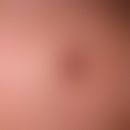Synonym(s)
HistoryThis section has been translated automatically.
DefinitionThis section has been translated automatically.
Malignant soft tissue sarcoma with cells that combine characteristics of histiocytes and fibroblasts Occurrence in the skin is rather rare; often originates from the fibrous connective tissue of the fascia and muscles and from bone tissue.
You might also be interested in
ClassificationThis section has been translated automatically.
Histologically, the following forms are distinguished between Enzinger and Weiss:
- Pleomorphic type (73% of cases)
- Myxoid type (19.5%)
- Giant cell type (3%)
- Xanthogranulomatous-angiomatoid type (2.5%)
- Inflammatory type (2%).
ManifestationThis section has been translated automatically.
Occurrence mainly 50th-70th LJ. Men are affected twice as often as women.
LocalizationThis section has been translated automatically.
ClinicThis section has been translated automatically.
Little characteristic clinical picture. Formation of a greyish-white or yellow to reddish-brown, coarse, usually broadly ulcerated nodule in the cutis and subcutis. All tumour types can infiltrate not only the subcutis but also the musculature and periosteum.
HistologyThis section has been translated automatically.
- There are storiform pleomorphic, myxoid, large cell and inflammatory types. Depending on the type, there are differently configured cells with vesicular, hyperchromatic nuclei and pleomorphic histiocytes with prominent nucleoli and vacuolated cytoplasm. Numerous atypical mitoses. In addition, bizarre mono- or multinuclear giant cells are often detectable.
- Immunohistologically, the diversity of the cell types involved is shown. Vimentin is positive. Visualization of histiocytes (MAC387 neg., CD68 neg., alpha-antichymotrypsin neg/pos.) as well as lysosomal histiocytes, myofibroblasts (alpha-SAM pos., muscle actin (HHF35) pos.) and dendritic cells (FXIII positive).
Differential diagnosisThis section has been translated automatically.
Radiation therapyThis section has been translated automatically.
Internal therapyThis section has been translated automatically.
Operative therapieThis section has been translated automatically.
Progression/forecastThis section has been translated automatically.
It's not a good time. The local recurrence rate is 19-31%. The metastasis is both lymphogenic and hematogenic. Metastasis rate: up to 30%. Remote metastasis varies according to the form. Average 5-year survival rate is 75% for the storiform-pleomorphic type. It is significantly worse in the inflammatory type.
Note(s)This section has been translated automatically.
LiteratureThis section has been translated automatically.
- Aoe K et al (2003) Malignant fibrous histiocytoma of the lung. Anticancer Res 23: 3469-3474
- Berth-Jones J et al (1990) Cutaneous malignant fibrous histicytoma. Ann Derm Venerol 70: 254-256
- Chang P et al (1994) Malignant fibrous histiocytoma of the skin. Int J Dermatol 33: 50-51
- Mentzel T (2002) Cutaneous mesenchymal neoplasms versus mesenchymal neoplasms of subcutaneous and deep soft tissue. Similarities and differences. Pathologist 23: 97-106
- O'Brien JE, Stout AP (1964) Malignant fibrous xanthoma. Cancer 17: 1445-1458
- Wanebo HJ et al (1995) Preoperative regional therapy for extremity sarcoma - a tricenter update. Cancer 75: 2299-2306
- Wiriosuparto S et al (2003) Malignant fibrous histiocytoma, giant cell type, of the breast mimicking metaplastic carcinoma. A case report. Acta Cytol 47: 673-678
Incoming links (8)
Cutaneous sarcomas (overview); Fibrosarcoma; Fibroxanthoma atypical; Fibroxanthosarcoma; Hemangiopericytoma; Malignant fibrous histiocytoma; Myxofibrosarcoma; Vimentin;Outgoing links (6)
Cyclophosphamide; Cytostatics (overview); Doxorubicin; Excision; Fibroxanthoma atypical; Vincrist;Disclaimer
Please ask your physician for a reliable diagnosis. This website is only meant as a reference.





